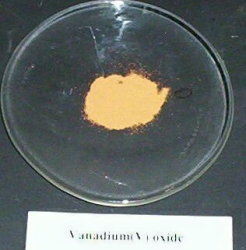![]() The Pacific War Online Encyclopedia
The Pacific War Online Encyclopedia
|
| Previous: Van Nuys | Table of Contents | Next: Vancouver, Canada |

Vanadium oxide. Via Wikimedia Commons
Vanadium is a scarce and expensive
alloying element, which cost $1.38 a
pound in 1959. It is a potent hardener for steels
and is
particularly useful for making steels that are resistant to creep and
fatigue,
such as spring steel. Vanadium steel was used in the chassis of the Ford Model T automobile,
and vanadium pentoxide is indispensible as a catalyst for the production of sulfuric
acid, one of the most important feedstocks in the chemical industry.
The principal ore of vanadium is carnotite, formed when groundwater percolates through volcanic ash beds and picks up heavy metals (including uranium as well as vanadium) and deposits these metals in organic debris. Germany and the Colorado Plateau in the American Southwest had significant carnotite deposits, but there were none to speak of in the Pacific basin. The Allies also had access to vanadium deposits as vanadium-bearing magnetite in ophiolites in South Africa, but the deposits in southwest China were not yet being exploited during the time frame of the Pacific War.
Japan was almost completely reliant upon the United States and Peru for vanadium prior to war, and imports all but ceased thereafter. Attempts to obtain vanadium from magnetite beach sands from Aomori prefecture were largely unsuccessful, and supplies of ferrovanadium were running very short by 1944.
References
U.S. Geological Survey (accessed 29 December 2006)
The Pacific War Online Encyclopedia © 2007, 2012-2013 by Kent G. Budge. Index